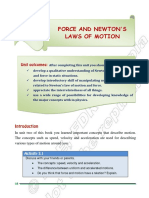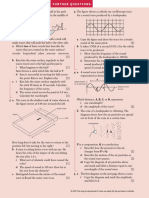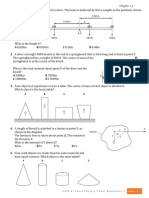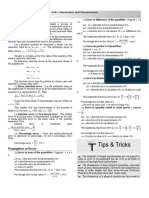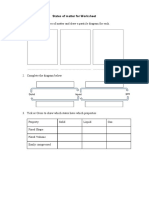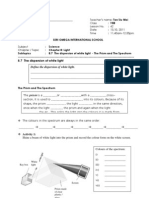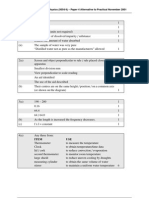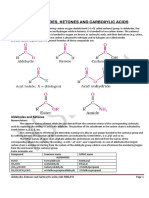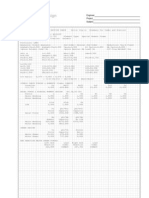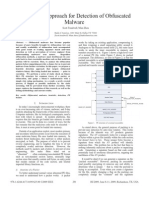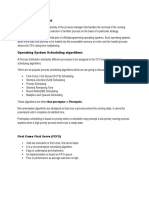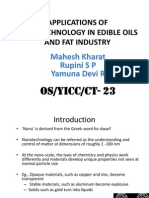0 ratings0% found this document useful (0 votes)
480 viewsOptics Worksheet
Optics Worksheet
Uploaded by
Syed Mairaj Ul HaqThis document provides information about geometrical optics and optical instruments. It covers topics such as lenses, focal length, magnification, and compound microscopes. Specifically, it defines key terms like converging lens, focus, and aperture. It also describes lens properties and combinations, including that a convex lens gives a virtual image when the object lies between the principal focus and optical center. Further, it addresses the magnification and focal lengths of simple microscopes and astronomical telescopes.
Copyright:
© All Rights Reserved
Available Formats
Download as DOCX, PDF, TXT or read online from Scribd
Optics Worksheet
Optics Worksheet
Uploaded by
Syed Mairaj Ul Haq0 ratings0% found this document useful (0 votes)
480 views2 pagesThis document provides information about geometrical optics and optical instruments. It covers topics such as lenses, focal length, magnification, and compound microscopes. Specifically, it defines key terms like converging lens, focus, and aperture. It also describes lens properties and combinations, including that a convex lens gives a virtual image when the object lies between the principal focus and optical center. Further, it addresses the magnification and focal lengths of simple microscopes and astronomical telescopes.
Original Description:
optics
Copyright
© © All Rights Reserved
Available Formats
DOCX, PDF, TXT or read online from Scribd
Share this document
Did you find this document useful?
Is this content inappropriate?
This document provides information about geometrical optics and optical instruments. It covers topics such as lenses, focal length, magnification, and compound microscopes. Specifically, it defines key terms like converging lens, focus, and aperture. It also describes lens properties and combinations, including that a convex lens gives a virtual image when the object lies between the principal focus and optical center. Further, it addresses the magnification and focal lengths of simple microscopes and astronomical telescopes.
Copyright:
© All Rights Reserved
Available Formats
Download as DOCX, PDF, TXT or read online from Scribd
Download as docx, pdf, or txt
0 ratings0% found this document useful (0 votes)
480 views2 pagesOptics Worksheet
Optics Worksheet
Uploaded by
Syed Mairaj Ul HaqThis document provides information about geometrical optics and optical instruments. It covers topics such as lenses, focal length, magnification, and compound microscopes. Specifically, it defines key terms like converging lens, focus, and aperture. It also describes lens properties and combinations, including that a convex lens gives a virtual image when the object lies between the principal focus and optical center. Further, it addresses the magnification and focal lengths of simple microscopes and astronomical telescopes.
Copyright:
© All Rights Reserved
Available Formats
Download as DOCX, PDF, TXT or read online from Scribd
Download as docx, pdf, or txt
You are on page 1of 2
Geometrical Optics
1. A lens which converges a beam of parallel rays to a point is called
A. diverging (or concave) lens B. converging (or convex) lens
C. plano concave lens D. plano convex lens
2. A point where the incident parallel rays of light converge or appear to diverge after passing
through a lens is called
A. center of curvature B. focus C. optical center D. aperture
3. The diameter of a lens is called
A. focal length B. principal axis C. aperture D. radius of
curvature
4. In going form a denser to rarer medium a ray of light is
A. undeviated B. bent away form the normal C. bent towards the normal
D. polarized
5. Unit of power of a lens is
A. meter B. watt C. dioptre D. horsepower
6. Dioptre power of an concave lens of 10 cm focal length is
A. 10 dioptre B. 10 dioptre C. 1 / 10 dioptre D. 1 / 10 dioptre
7. The power of a concave lens is
A. real B. virtual C. positive D. negative
8. The minimum distance between an object and its real image in a convex lens is
A. 2 f B. 2.5 f C. 3f D. 4f
9. If an object is placed away from 2f of a converging lens then the image will be
A. real and erect B. virtual and erect C. real and inverted D. virtual
10. A convex lens gives a virtual image only when the objects lies
A.between principal focus and center of curvature B. beyond 2 f
C. at the principal focus D. between principal focus and optical center
11. Magnifying power of simple microscope
A. increase with increase in focal length B. increase with decrease in focal
length
C. no effect with decrease or increase with focal length D. list distance of
distinct vision
12. Image of an object 5 mm high is only 1 cm high. Magnification produced by lens is
A. 0.5 B. 0.2 C. 1 D. 2
13. The least distance of distinct vision for a normal eye is
A. 15 cm B. 25 cm C. 30 cm D. 40 cm
14. Least distance of distinct vision
A. increases with increase in age B. decreases with increase in age
C. neither increases nor decreases D. becomes infinite after 60 years
16. Two convex lenses of equal focal length f are placed in contact the resultant focal length
of the combination is
A. zero B. focus C. 2 f D. f/2
17. A convex lens of focal length f1 and a concave lens of focal length f2 are placed in
contact. The focal length of the combination is
A. f2 + f1 B. f2 - f1 C. f1f2/f2+f1 D. f1f2/f1-f2
18. Final image produced by a compound microscope is
A. real and inverted B. real and erect C. virtual and erect D. virtual
and inverted
19. For normal adjustment, length of astronomical telescope is
A. fo + fe B. fo fe C. fo / fe D. fe / fo
20. In multimode step index fibre the refractive index of core and cladding is
A. same B. different C. zero D. different with refractive index of core higher
than cladding
You might also like
- Reflection IGCSE ExerciseDocument1 pageReflection IGCSE Exercisefakhrizal2018No ratings yet
- Unit 3: Force and Newton'S Laws of MotionDocument27 pagesUnit 3: Force and Newton'S Laws of Motionelty TanNo ratings yet
- 1.7 Energy Work and Pressure Igcse - Cie - PhysicsDocument26 pages1.7 Energy Work and Pressure Igcse - Cie - Physicsestrellasuha424100% (1)
- Physics 11: Hooke's Law WorksheetDocument4 pagesPhysics 11: Hooke's Law WorksheetMiguel RuizNo ratings yet
- Class Test 1 (Light) - AnswersDocument7 pagesClass Test 1 (Light) - Answerskeyur.gala0% (1)
- Electro Magnetic FieldDocument7 pagesElectro Magnetic FieldAkshat Kumar AgarwalNo ratings yet
- Physics Worksheet For Grade - 10 (Part - 2) Ebenezer School (From K-G Up To Preparatory)Document6 pagesPhysics Worksheet For Grade - 10 (Part - 2) Ebenezer School (From K-G Up To Preparatory)YishakNo ratings yet
- Physics Worksheet # 1 (Measurements) NameDocument7 pagesPhysics Worksheet # 1 (Measurements) NameSalmanR100% (1)
- Cambridge IGCSE: Physics 0625/22Document16 pagesCambridge IGCSE: Physics 0625/22jad obaidNo ratings yet
- Electromagnetic Effects WORKSHEETDocument5 pagesElectromagnetic Effects WORKSHEETTanishka TiwariNo ratings yet
- A Summer Job ComprehensionDocument4 pagesA Summer Job Comprehensionusmaniibrahim052No ratings yet
- Current Electricity - (Worksheet)Document3 pagesCurrent Electricity - (Worksheet)s.hiruthivNo ratings yet
- Magnetic Field WorksheetDocument6 pagesMagnetic Field WorksheetmayaNo ratings yet
- Trigonometry BearingsDocument6 pagesTrigonometry Bearingssanand11No ratings yet
- Igcse Phy 06Document2 pagesIgcse Phy 06Kamrul Hasan SagarNo ratings yet
- 43.1-Electric Circuits-Cie Igcse Physics Ext-Theory-QpDocument13 pages43.1-Electric Circuits-Cie Igcse Physics Ext-Theory-Qptoilet.rouletteNo ratings yet
- Chapter 5Document15 pagesChapter 5jesunathan44@yahoo.comNo ratings yet
- Level Past Paper Questions - Physics O: TOPIC-3 Force, Vectors and Scalars 7Document12 pagesLevel Past Paper Questions - Physics O: TOPIC-3 Force, Vectors and Scalars 7elty TanNo ratings yet
- 1.5 Forces WS 2Document2 pages1.5 Forces WS 2AHNAF CREATIONNo ratings yet
- IGCSE Vector NotesDocument13 pagesIGCSE Vector NotesShaimaa El-sayed MetwallyNo ratings yet
- MomentumDocument21 pagesMomentumSam Hnatiuk0% (1)
- Cie Igcse Physics Chapter 2 2023 OnwDocument10 pagesCie Igcse Physics Chapter 2 2023 OnwZeinab ElkholyNo ratings yet
- General Wave Properties 3 QPDocument8 pagesGeneral Wave Properties 3 QPshadybitxhespamNo ratings yet
- 2016 IB Physics - Motion and ForcessDocument5 pages2016 IB Physics - Motion and ForcessGajendra100% (1)
- Directions: Choose The Best Answer For Each Multiple Choice Question. Write The Best Answer On The BlankDocument3 pagesDirections: Choose The Best Answer For Each Multiple Choice Question. Write The Best Answer On The BlankRanulfo MayolNo ratings yet
- Past Paper Qs Electric CurrentDocument57 pagesPast Paper Qs Electric CurrentMichael lIuNo ratings yet
- QP LightDocument7 pagesQP LightRohaan GopinathNo ratings yet
- Errors of Measurement: Units, Dimensions and MeasurementDocument3 pagesErrors of Measurement: Units, Dimensions and Measurementpnkjkum100% (1)
- ICSE Class 8 Physics Sample Paper 2Document5 pagesICSE Class 8 Physics Sample Paper 2madhumitra mohantyNo ratings yet
- Work Sheet - 1 Name of The Student: - Class:-10 Sec - Academic YearDocument4 pagesWork Sheet - 1 Name of The Student: - Class:-10 Sec - Academic YearunniNo ratings yet
- 32.4-Light-Cie Igcse Physics Ext-Theory-Qp 2Document10 pages32.4-Light-Cie Igcse Physics Ext-Theory-Qp 2LiliNo ratings yet
- Paper 2 May 2002 PhysicsDocument16 pagesPaper 2 May 2002 PhysicssolarixeNo ratings yet
- 1st Semester WorksheetsDocument42 pages1st Semester WorksheetsMang friesNo ratings yet
- Worksheet States of MatterDocument6 pagesWorksheet States of MatterPRUTHIVI BEHRANo ratings yet
- Light Worksheet 0625Document14 pagesLight Worksheet 0625M. Amaan AamirNo ratings yet
- ACS2020 6091 Sec 4 Prelim Pract Exam Question PaperDocument14 pagesACS2020 6091 Sec 4 Prelim Pract Exam Question PaperYINJIAYI HOUNo ratings yet
- 0607 w18 QP 63 PDFDocument16 pages0607 w18 QP 63 PDFbec dikshitarNo ratings yet
- Light 7Document5 pagesLight 7ahmeiNo ratings yet
- Topic 2 Practice MSDocument88 pagesTopic 2 Practice MSAmina RakhaNo ratings yet
- Worksheet 10Document3 pagesWorksheet 10JunLi CaiNo ratings yet
- Work With FunDocument8 pagesWork With FunnooriNo ratings yet
- Beaconhouse School System Southern Region Middle I, Gulshan Chapter Remedial Worksheet 4 Class VIIIDocument7 pagesBeaconhouse School System Southern Region Middle I, Gulshan Chapter Remedial Worksheet 4 Class VIIIMustufa KhalilNo ratings yet
- IGCSE Physics 0625 - 01 Light - JWDocument327 pagesIGCSE Physics 0625 - 01 Light - JWA Rathika Kalyani [PPSB]No ratings yet
- Test 3Document4 pagesTest 3Izan FarizanNo ratings yet
- Introduction To Direct ProportionsDocument3 pagesIntroduction To Direct ProportionsRashmiNo ratings yet
- IGCSE Formula BookletDocument4 pagesIGCSE Formula BookletNisalNo ratings yet
- Topic 4 Waves Student WorkbookDocument23 pagesTopic 4 Waves Student WorkbookpixelhoboNo ratings yet
- Simple Phenomena of Magnetism 1 QPDocument11 pagesSimple Phenomena of Magnetism 1 QPnssNo ratings yet
- Igcse 15 TheturningeffectofforcesDocument23 pagesIgcse 15 TheturningeffectofforcesHany ElGezawyNo ratings yet
- Ol Phy1 Mock7Document14 pagesOl Phy1 Mock7Shabbir H. Khan100% (1)
- 113184208-Ppt-Properties of Light and The Image FormationDocument50 pages113184208-Ppt-Properties of Light and The Image FormationAzmi HolisNo ratings yet
- Electrostatics McqsDocument5 pagesElectrostatics McqsKhan Tahir100% (1)
- 22.electromotive Force and Potential DifferenceDocument4 pages22.electromotive Force and Potential DifferenceSyed Mairaj Ul HaqNo ratings yet
- WORKSHEET 12 - Parallel and Series CircuitsDocument7 pagesWORKSHEET 12 - Parallel and Series CircuitsPaliNo ratings yet
- ICSE Class 10 PhysicsDocument5 pagesICSE Class 10 Physicssudhir_narang_3No ratings yet
- Exercise 7Document3 pagesExercise 7Tanzim RahmanNo ratings yet
- Paper 4 Nov 2001 PhysicsDocument2 pagesPaper 4 Nov 2001 Physicssolarixe100% (1)
- Quiz 2 Physics X 2024-2025Document2 pagesQuiz 2 Physics X 2024-2025masternomi2002No ratings yet
- Light-Mirrors and Lens WorksheetDocument2 pagesLight-Mirrors and Lens WorksheetTharuna100% (1)
- Summative Test 3 MirrorLensDocument2 pagesSummative Test 3 MirrorLensAna Marie GanibanNo ratings yet
- Ba Bcom Basc Weekly TestDocument1 pageBa Bcom Basc Weekly TestSyed Mairaj Ul HaqNo ratings yet
- Math 1st Year2Document4 pagesMath 1st Year2Syed Mairaj Ul HaqNo ratings yet
- Xii CGDocument59 pagesXii CGSyed Mairaj Ul HaqNo ratings yet
- Ba Bcom Basc Weekly TestDocument1 pageBa Bcom Basc Weekly TestSyed Mairaj Ul HaqNo ratings yet
- Wave Notes 3 - Reflection1Document5 pagesWave Notes 3 - Reflection1Syed Mairaj Ul HaqNo ratings yet
- Professor Jee Collegiate: Class IxDocument2 pagesProfessor Jee Collegiate: Class IxSyed Mairaj Ul HaqNo ratings yet
- Bcom II Management NotesDocument81 pagesBcom II Management NotesSyed Mairaj Ul HaqNo ratings yet
- Energy Notes 3 - Conservation of EnergyDocument5 pagesEnergy Notes 3 - Conservation of EnergySyed Mairaj Ul HaqNo ratings yet
- Stars Academy: PU Pharm.D Mcat Ecat NTS Fast Nust Giki LumsDocument2 pagesStars Academy: PU Pharm.D Mcat Ecat NTS Fast Nust Giki LumsSyed Mairaj Ul HaqNo ratings yet
- Wave Notes 4 - Refraction1Document5 pagesWave Notes 4 - Refraction1Syed Mairaj Ul HaqNo ratings yet
- Ali Notes For CentreDocument5 pagesAli Notes For CentreSyed Mairaj Ul HaqNo ratings yet
- Personal Details: Applicatin Form For TutorDocument13 pagesPersonal Details: Applicatin Form For TutorSyed Mairaj Ul HaqNo ratings yet
- Ministry of Inter Provincial Coordination (IPC Division) : S T NS T NDocument3 pagesMinistry of Inter Provincial Coordination (IPC Division) : S T NS T NSyed Mairaj Ul HaqNo ratings yet
- Xi-Xii Coaching ProgramDocument1 pageXi-Xii Coaching ProgramSyed Mairaj Ul HaqNo ratings yet
- UHS MCAT Entry Test Syllabus 2015Document36 pagesUHS MCAT Entry Test Syllabus 2015Shawn Parker89% (9)
- Aldehydes, Ketones and Carboxylic Acids-Anil-hssliveDocument16 pagesAldehydes, Ketones and Carboxylic Acids-Anil-hssliveRanit Mukherjee100% (1)
- Flexible Budget-SolutionDocument3 pagesFlexible Budget-SolutionThe GentlemanNo ratings yet
- Atomic Structure: By:-Abhinav Amol SomwanshiDocument33 pagesAtomic Structure: By:-Abhinav Amol SomwanshimadhurisdnyankunjNo ratings yet
- Assignment 1 - Financials Considerations and Project SelectionDocument3 pagesAssignment 1 - Financials Considerations and Project Selectionchesterbang11No ratings yet
- Rounding Significant Figures - 01Document5 pagesRounding Significant Figures - 01Mohummed IbraheemNo ratings yet
- Moredo, Eloisa Joy R.: Requirement 1Document4 pagesMoredo, Eloisa Joy R.: Requirement 1Eloisa Joy MoredoNo ratings yet
- ETABSDocument1 pageETABSJasser BerriosNo ratings yet
- EC8904 Satellite CommunicationDocument64 pagesEC8904 Satellite Communication19025 GEORGE.JNo ratings yet
- Analisis Runtun Waktu Dan Peramalan Tugas 4Document12 pagesAnalisis Runtun Waktu Dan Peramalan Tugas 4Qardawi HamzahNo ratings yet
- Variables Control ChartDocument60 pagesVariables Control ChartGhani RizkyNo ratings yet
- fluid1Document5 pagesfluid1English DemoNo ratings yet
- High-Efficiency, 2A, 16V, 500Khz Synchronous, Step-Down Converter in A 6-Pin Tsot 23 Description FeaturesDocument17 pagesHigh-Efficiency, 2A, 16V, 500Khz Synchronous, Step-Down Converter in A 6-Pin Tsot 23 Description FeaturesAnonymous qpnZNmchFdNo ratings yet
- 950H Diagrama HidraulicoDocument2 pages950H Diagrama HidraulicoEduardo VargasNo ratings yet
- Magnetism in SolidsDocument11 pagesMagnetism in SolidsNeelam KapoorNo ratings yet
- Bilge Water SeparatorDocument121 pagesBilge Water SeparatorКостяNo ratings yet
- Importance of UnitsDocument1 pageImportance of UnitsMuhammad Hannan SiddiquiNo ratings yet
- Analysis of Ethanol in Blood With The Agilent 7820A GC and 7697A Headspace SamplerDocument6 pagesAnalysis of Ethanol in Blood With The Agilent 7820A GC and 7697A Headspace SamplerAdrián Rojas ÁvilaNo ratings yet
- Chapter 8 The Milky Way GalaxyDocument21 pagesChapter 8 The Milky Way GalaxyCrystal Gyle FunaNo ratings yet
- Nuclear Medicine Lesson 1 013328Document37 pagesNuclear Medicine Lesson 1 013328Sam SammyNo ratings yet
- Pitchbook_Global M&a Report_FY2023 (31 Pgs)Document31 pagesPitchbook_Global M&a Report_FY2023 (31 Pgs)mohammedkalandermashukNo ratings yet
- Omni - AW3464-PDataSheetDocument2 pagesOmni - AW3464-PDataSheetJosueMancoBarrenecheaNo ratings yet
- 1989 - Haroche Kleppner - Phys Today - CQED PDFDocument8 pages1989 - Haroche Kleppner - Phys Today - CQED PDFkrisNo ratings yet
- Adam Taylor EV - CREATIONDocument33 pagesAdam Taylor EV - CREATIONShad MiaNo ratings yet
- ReasoningDocument577 pagesReasoningkitsuneNo ratings yet
- 05137328Document9 pages05137328Ramtin DehzadNo ratings yet
- Chemistry II (Em) 21-22 BLM Final 22Document49 pagesChemistry II (Em) 21-22 BLM Final 22Poonith ValikiNo ratings yet
- GeoControl Desert River Tutorial - JykkeDocument12 pagesGeoControl Desert River Tutorial - JykkeThomas HenryNo ratings yet
- Process SchedulingDocument5 pagesProcess SchedulingKnoel Gen GutierrezNo ratings yet
- Applications of Nanotechnology in Edible Oils and FatDocument35 pagesApplications of Nanotechnology in Edible Oils and FatmmkharatNo ratings yet
- Liebert Gxt4 Ups 120208v 500va 3000va User Manual SL 23193Document66 pagesLiebert Gxt4 Ups 120208v 500va 3000va User Manual SL 23193Alejandro Miranda HernándezNo ratings yet

